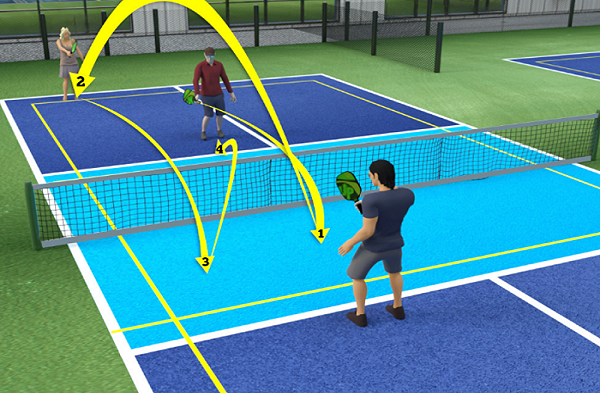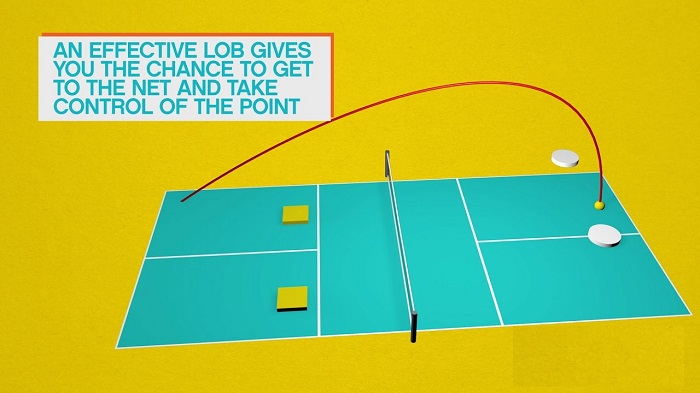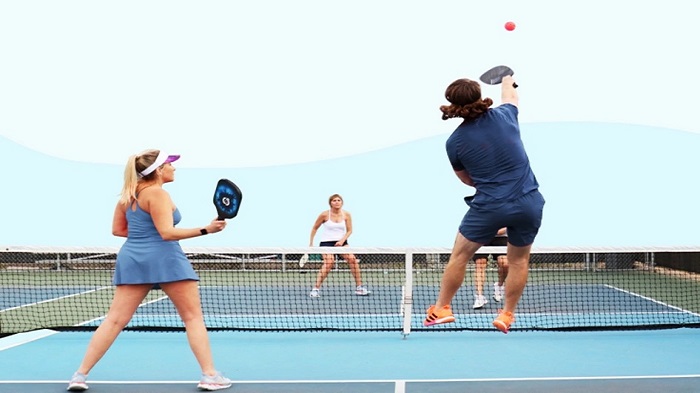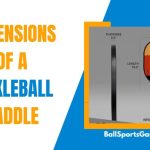If you as me what is a lob in pickleball, then let me start from the basics. Pickleball is an exciting, fast-paced racquet sport that calls for players to master a range of shots. Lob shot is the most effective strategy of all. It involves sending the ball soaring high over your opponent’s head and into their court.
This can give you the opportunity to get back into position and gain a strategic advantage in the match. With the perfect lob shot, you can catch your opponent off-guard and come out on top.

Whether you’re at the back of the court needing to create space or your opponent is up close crowding the net, a well-executed lob shot can make all the difference in winning a match. But it takes time and practice to perfect this tricky stroke. It takes some time to master it, meanwhile don’t be discouraged.
If you’re a beginner or a seasoned player. Also learning how to hit a successful pickleball lobs shot is an essential skill to have. With a bit of practice and strategy, the lob shot can become a valuable tool to add to your game. It gives you an edge on the court and helps you dominate your opponents.
Types of pickleball Lobs
In pickleball, “lob” refers to a high, arching shot that is hit over an opponent’s head. It intended to land deep in their court. There are generally two types of lobs in pickleball.
Offensive lob
There are two different ways to execute lob shots in pickleball. The first one is the Regular or Basic Lob which is a simple offensive shot. It involves slightly opening the paddle and moving it from low to high.
For a more effective hit, it is recommended to use the body rather than just the arm to swing. The Backhand and forehand lob are executed in a similar way to a dink shot. With a pronounced follow-through to send the ball higher and a greater distance.
Defensive lob
The second type of lob shot is the Top Spin Lob. Which is an advanced player’s offensive play that requires more paddle skill. It is to make it rotate with the paddle face to achieve that stroke.
A strong upward motion is necessary to give it a heavy topspin. The Top Spin Lob is difficult. Because the spin makes the ball bounce away, making it harder to run down.
Tips for the Perfect Lob on the Pickleball Court
Let us see some useful tips to master pickleball Lobs
Preparation
To prepare for a lob, you should approach it in a similar manner to a drop shot or a dink. It is most effective if you do not expect it. As It is crucial to disguise the lob. If you observe a pickleball player standing tall and leaning back. Particularly if this player bends their knees and stays compressed, they may be executing a lob.
Therefore, it is essential to get ready for the lob as you would for a drop or a dink at the Kitchen line. This necessitates positioning your body behind the pickleball with your paddle held in front of your body. Also below the pickleball in a compressed stance, with your knees bent.

Forehands Preferred
Forehand lobs are generally preferred over backhand lobs to achieve more consistency and ease. As you move behind the pickleball, prepare your feet to position the ball on your forehand side.
Then, turn your shoulders and upper body slightly towards your paddle side, bend your knees, and compress your body into your paddle-side hip and knee. Once again, this bending and compression motion should mirror your drop or dink mechanics.
Short Backswings
To lift the pickleball into the air, compress it underneath it and take a brief backswing. It is critical to conceal this shot as much as possible. So attempt to limit your backswing while still generating some power.
Target the Player with Weak Mobility
To make your opponents move back on the pickleball court, aim for the player with the weakest mobility. Additionally, take into account the height of your opponents. Is one of them shorter than the other, providing an opportunity for an easy lob?
While a lob can be effective in pickleball, avoid relying on it excessively. Keep your shot selection unpredictable to keep your opponents on their toes.
Aim for the Non-Paddle Side
To require your opponents to move around the pickleball for an overhead shot or to hit a high backhand, lob towards their non-paddle side.
Hitting a high backhand is typically their weaker side, and making them run around the ball can tire them out. If you lob towards their paddle side, you could be giving them an easy opportunity for a forehand overhead shot.
Top Spin
To make your shot more offensive, incorporate topspin into your lob. This will make it harder for your opponents to track down as the added pace will create a more challenging shot. Additionally, topspin can prevent your lob from sailing out of bounds. It helps pull the pickleball down towards the court. Also, the top spin is more helpful in a pickleball singles as the opponent will close to net.
To execute a lob with topspin, start your paddle below the contact point of the pickleball and use a pronation motion with your wrist, elbow, and shoulder, tilting the paddle towards the sky. Think of this motion as a windshield wiper with your paddle and joints.
The goal is to grip the bottom of the pickleball with the top of your paddle face. Which roll your paddle up the backside of the pickleball. It creates friction that will generate the desired topspin on the pickleball.

Out Front & Follow Through
To make your shot more offensive, incorporate topspin into your lob. This will make it harder for your opponents to track down as the added pace will create a more challenging shot. Additionally, topspin can prevent your lob from sailing out of bounds as it helps pull the pickleball down.
To execute a lob with topspin, start your paddle below the contact point of the pickleball and use a pronation motion with your wrist, elbow, and shoulder, tilting the paddle towards the sky. Think of this motion as a windshield wiper with your paddle and joints.
The goal is to grip the bottom of the pickleball with the top of your paddle face and roll your paddle up the backside of the pickleball, creating friction that will generate the desired topspin on the pickleball.
What is an offensive lob in pickleball?
For an offensive lob in pickleball, aim for a flatter trajectory that curves just over the top of your opponent’s reach, landing in the court behind them. This type of shot is intended to be an aggressive play. It also puts pressure on your opponents.
An offensive lob is especially effective when your opponent is near the edge of the Non-Volley Zone (NVZ) line, also known as “The Kitchen”. This forces your opponent to quickly move back to return the shot, giving you an opportunity to take control of the point.
What is a Defensive Lob in Pickleball?
If you find yourself in a situation where your opponent is taking control of the point and you need to stay in the rally, a high lob in pickleball can be a smart and safe option. This type of shot is meant to be defensive and can give you the necessary time to reposition for the next volley.
When hitting a defensive lob, aim for a higher arc that keeps the ball in the air longer. Keep in mind that this can also give your opponent more time to choose their best shot. which could potentially be a fast overhead hit back at you.
Read More : how to keep score in pickleball
How do you hit an offensive and defensive lob?
Both techniques are similar to each other. Let’s see what are key differences between offensive and defensive lob.
Offensive
Executing a successful offensive lob requires both technique and strategy. You should angle the paddle face slightly upward and follow through with an out-and-up motion. Your weight should be in the direction of your intended target, and you should be in a balanced position to get the paddle under the ball and lift it upwards with your knees.
It is important to have the contact point in front of you and avoid stretching to reach the ball to maintain control. According to coach Simone Jardim, “the finer points of perfect offensive lob technique should be considered”.
Defensive
Similar to an offensive lob, hitting a defensive lob also requires good technique. However, there are two primary differences in the angle of your paddle at the point of contact and the direction of your follow-through.
For a defensive lob, your paddle’s open face should point more toward the sky, and your follow-through should rise vertically, unlike the out-and-away motion used in an offensive lob. To gain better control, you should get low, position your paddle beneath the ball, and guide and lift it upwards using your knees and weight instead of slapping the ball with a flick of the wrist.
Beginners vs. Pro Player Lob Shots
Beginners are more susceptible to lobs since they often struggle to hit a return shot with them. Additionally, older players with limited mobility also tend to struggle against lobs. However, advanced players are skilled at returning lobs. A poorly executed lob could provide them with the perfect opportunity for an overhead smash.
At the professional tournament level, pro pickleball players are quick enough to get underneath a lob and return it successfully. Therefore, it is crucial to disguise the lob and catch your opponent off-guard to make it effective.
How To Defend a Lob Shot
When planning a defensive shot for an effectively placed lob shot, consider the following options:
- Overhead Shot – The best return for a lob is to reach it out of the air before it bounces by using an overhead smash. This shot is executed by extending the paddle high with the elbow straight when the ball is contacted. It is difficult to hit a shot for the returning player. That is why advanced pickleball players tend not to use a lob.
- Drop – If the lob lands in the court behind you, it’s best to run it down and hit a drop. A drop shot is a soft shot from the back of the court intended to land in the opponent’s non-volley zone. It is also allowing you to return to the kitchen zone.
- Drive or Defensive Lob – If you can’t use an overhead or a drop, use a low drive which will hopefully allow you to drop on the next shot and follow it up to the NVZ line. If you’re on the defensive, throw up a lob defensively as a return shot to buy yourself some more time to set up for the next shot.
FAQs
In pickleball, the lob shot is ideal to use when you want to push your opponent back or buy time to regain control of the point, especially when they are at the net. This type of shot can also be effective if your opponent is at the edge of the Non-Volley Zone (NVZ) line, known as “The Kitchen,” as they will have to scramble backwards to return the shot.
To successfully execute a lob shot, position your paddle with the face angled slightly upward and follow through with an out-and-up motion. Ensure that you are in a balanced position and lift the ball upside by getting your paddle under the ball. Now lift with your knees while shifting your weight in the direction of your intended target.
When playing against advanced pickleball players who possess good mobility, lobs may not be as effective since they can quickly get into position to return the shot. Nonetheless, a lob shot executed with precision can still catch even advanced players off-guard. By disguising your lob shot, you may still gain the upper hand against your opponent, even if they are experienced in the game.
When hitting a successful lob shot pickleball, you should aim to land the ball deep in your opponent’s court. Disguise the shot by mixing up your shots. This strategy is only effective when your opponent is close to the net, give chance to push them back. keeping a balanced position by using your knees to lift the ball upside, are also important for executing a successful lob.
Final Thoughts
By now you know what is a lob in pickleball and lob is a critical skill to master in order to improve and compete in all levels of pickleball. It has become increasingly popular. And making it more important than ever to know how to execute a successful lob and respond to them effectively. Luckily, learning different types of lobs and their techniques and strategies is not difficult. With practice, anyone can become a master of the lob in no time.
I am always here to provide you with pieces of information and insights about pickleball.



